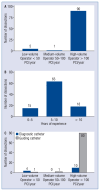Catheter-induced coronary artery and aortic dissections. A study of mechanisms, risk factors and propagation causes
- PMID: 35762078
- PMCID: PMC11229813
- DOI: 10.5603/CJ.a2022.0050
Catheter-induced coronary artery and aortic dissections. A study of mechanisms, risk factors and propagation causes
Abstract
Background: Only the incidence, management, and prognosis of catheter-induced coronary artery and aortic dissections have been systematically studied until now. We sought to evaluate their mechanisms, risk factors, and propagation causes.
Methods: Electronic databases containing 76,104 procedures and complication registries from 2000-2020 were searched and relevant cineangiographic studies adjudicated.
Results: Ninety-six dissections were identified. The overall incidence was 0.126%, and 0.021% for aortic injuries. The in-hospital mortality rate was 4.2%, and 6.25% for aortic dissections. Compared to the non-complicated population, patients with dissection were more often female (48% vs. 34%, p = 0.004), with a higher prevalence of comorbidities such as hypertension (56% vs. 25%, p < 0.001) or chronic kidney disease (10% vs. 4%, p = 0.002). They more frequently presented with acute myocardial infarction (72% vs. 43%, p < 0.001), underwent percutaneous coronary intervention (85% vs. 39%, p < 0.001), and were examined with a radial approach (77% vs. 65%, p = 0.011). The most prevalent predisposing factor was small ostium diameter and/or atheroma. Deep intubation for support, catheter malalignment, and vessel prodding were the most frequent precipitating factors. Of the three dissection mechanisms, 'wedged contrast injection' was the commonest (the exclusive mechanism of aortic dissections). The propagation rate was 30.2% and led to doubling of coronary occlusions and aortic extensions. The most frequent progression triggers were repeat injections and unchanged catheter. In 94% of cases, dissections were inflicted by high-volume operators, with ≥ 5-year experience in 84% of procedures. The annual dissection rate increased over a 21-year timespan.
Conclusions: Catheter-induced dissection rarely came unheralded and typically occurred during urgent interventions performed in high-risk patients by experienced operators.
Keywords: catheter-induced coronary dissection; iatrogenic aortocoronary dissection; percutaneous coronary intervention complications.
Conflict of interest statement
Figures



References
-
- Gómez-Moreno S, Sabaté M, Jiménez-Quevedo P, et al. Iatrogenic dissection of the ascending aorta following heart catheterisation: incidence, management and outcome. EuroIntervention. 2006;2(2):197–202. - PubMed
MeSH terms
LinkOut - more resources
Full Text Sources
